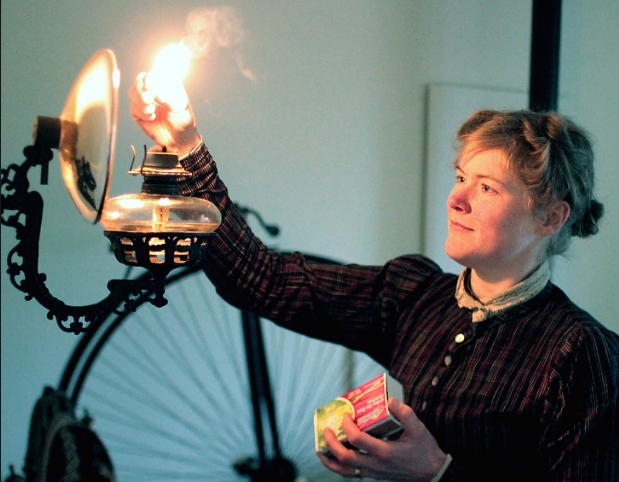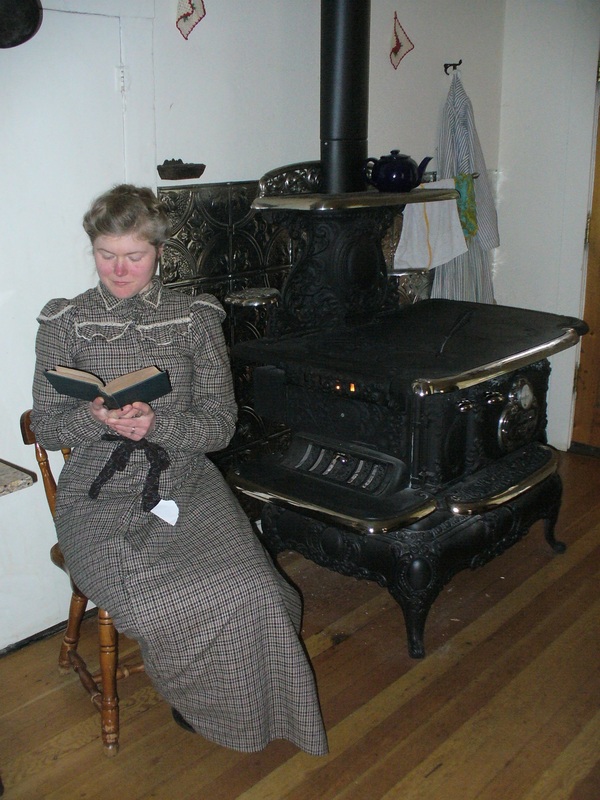The light fades quickly at this time of year. Even when the sun is up there is a dim, slanted quality to it which differs from the daylight of summer. Yet even this altered light is better than none, and I've learned to take advantage of its brief hours.
One of my first tasks of the day is to clean out the ashes in our stove from the fires of the day before. Sometimes I'm able to do this at night before going to bed, but Gabriel gets home so late from work most evenings and our supper is so late, the embers are often still too hot to empty before we retire for the night. So it waits until morning, which is not such a bad thing after all since it is easier by the growing light of morning than in the darkness of night.
When we first got our stove I used to clean it and lay the first fire through the same door fuel goes into the fire box; I felt rather silly for having done this when I realized how much easier the fire box is to access if I simply take the lids off the top. (The side door is for access when a fire is actively burning, so that the heat and smoke don't billow out.) After the lids are off I sweep the cold ashes down through the grate and take the tray from the side of the stove out to the garbage, along with a sieve and a small metal bucket. I sift the ashes over the garbage, and any bits of charcoal large enough to be caught in the sieve are saved and transferred to the bucket. It takes only a short time, and then I go back inside to lay the first fire of the day.
First I lay down waste paper —crumpled, so that air can flow freely around it. I make sure that there's an edge close to the firebox opening where I can reach it with a match, and that the edge I'll be lighting is either torn or cleanly cut, not folded since folds don't ignite quite so readily. Next comes tinder of various sorts: I often have soiled waxed paper left over from baking, which is one of the best materials I know for starting a fire. If my pencils want sharpening I'll do it over the open fire pit and let the shavings fall down onto the pile I'm building. I empty the used match receptacles by the oil lamps upstairs and add those as well, and if I have any cardboard a few scraps go in at this point. Over this I place kindling (smallest bits first), then wood, then I pour the charcoal scraps from the old fire over the top before I replace the stove lids, open all the dampers, and light the bottom paper through the door on the firebox. Soon there'll be a merry roar in the background as I go about my work for the day.
The antique books I use in my research are often faded with age and their print was small to begin with, so in general it's easiest to take notes by daylight and compose new material at night if I have any choice in the matter. Adding to this preference is the fact that notes from antique books are taken with pencil (to avoid getting ink on the books), whereas I prefer to write new material with my fountain pen, and it's easier to read pen marks than pencil by lamplight.
Filling one oil lamp by the light of another is a devilishly tricky business, so I try to check all my lamps and the kerosene Perfection heater at mid-day, when the natural light is brightest. If other work pleads priority and I neglect this task, the lowering of the light in the sky reminds me of it by four, and I rush to complete it while it may still be done by daylight.
There's more to tending a lamp than simply adding more fuel, and by habit I start with the wicks. To access a circular wick like those on our Miller or our Rayo lamp, (or the huge circular wick—as big as my fist—on our Perfection heater) I take the flame spreader off first and wipe the soot from it with an old rag. I turn the wick up just a little, so that a millimeter or so of it is visible, then I wrap a clean part of the rag around my forefinger and wipe it over the wick in a smooth, clockwise motion to knock off any char. This done, the flame spreader goes back in place and I fill the fuel reservoir, then wash the lamp's glass chimney if it wants it. Cleaning lamp chimneys is a less onerous task than my grandmother always claimed it to be, and also a less frequent one than I expected before we started living the way we do. A sooty lamp chimney is a sign of a lamp that's been turned up too high, and we try not to be so careless —particularly since the heat of too large a flame can crack the glass of the chimney. Since we've gotten the knack of having the wicks at just the right level —high enough for maximum light, but not so high that they smoke— I wash the lamp chimneys for dust nearly as often as I wash them for soot, and neither task has to be performed every time the lamps are filled.
Flat wicks are an older lamp technology than circular wicks, and instead of being smoothed and rubbed like their higher-tech cousins, flat wicks just get a simple cut, straight across, to trim them.
By five p.m., after I've worked as long as possible by the last scraps of daylight fading in a west-facing window, the descending night will already make me light one of my lamps, and I usually choose one with a circular wick since they are so much brighter. When we got our first circular wick lamp I was amazed how much brighter it was than its predecessors, but a simple consideration of the physics involved made the reason obvious: the circular wicks burn with a much larger flame, since instead of a short, straight line the wick's burning surface constitutes the entire circumference of a circle.
Yesterday the stormy weather brought on darkness so early that I already found myself wanting a lamp at half past four. I duly lit our bright Miller lamp, and smiled at the cozy smell of the kerosene. There is something very comforting in that scent, like the essence of home. When electric lights first came into fashion women called them cruel for the way they showed up all imperfections; they even said electric light made people look dead. The light of an oil lamp is warm, and welcoming, and very much alive.
The hours of darkness are long in winter. The scant daylight time is so devoted to tasks that will warm our weak human frames and let us see when the night comes; sometimes it feels as though life at this time of year is devoted to the service of fire. Yet let no one call it burdensome, for tending the hearth and keeping the lamps of home burning is one of the most sacred of all ancient duties. The goddess Hestia is much in my thoughts at this time of year. Though entitled to her place at the table with the other gods of Olympus, she chose —and was happiest— with her seat by the hearth.







 RSS Feed
RSS Feed